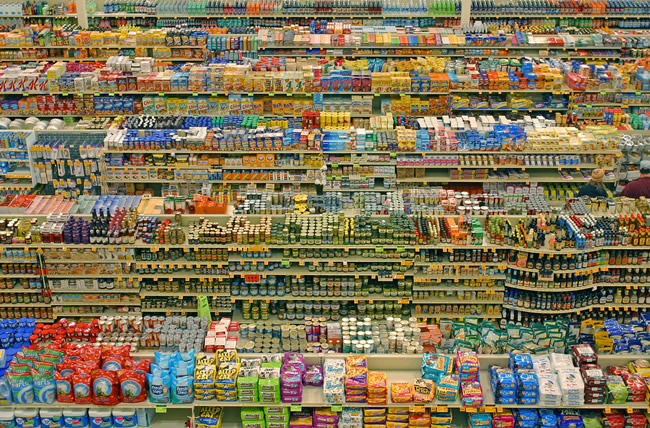 For watchers of the human condition, dissecting and analyzing our food culture is both fascinating and troubling. The global agricultural-industrial complex with its enormous efficiencies and finely engineered end-products, churns out mountains of food stuffs that help feed a significant proportion of the world. And yet, many argue that the same over-refined, highly-processed, preservative-doped, high-fructose enriched, sugar and salt laden, color saturated foods are to blame for many of our modern ills. The catalog of dangers from that box of “fish” sticks, orange “cheese” and twinkies goes something likes this: heart disease, cancer, diabetes, and obesity.
For watchers of the human condition, dissecting and analyzing our food culture is both fascinating and troubling. The global agricultural-industrial complex with its enormous efficiencies and finely engineered end-products, churns out mountains of food stuffs that help feed a significant proportion of the world. And yet, many argue that the same over-refined, highly-processed, preservative-doped, high-fructose enriched, sugar and salt laden, color saturated foods are to blame for many of our modern ills. The catalog of dangers from that box of “fish” sticks, orange “cheese” and twinkies goes something likes this: heart disease, cancer, diabetes, and obesity.
To counterbalance the fast/processed food juggernaut the grassroots International Slow Food movement established its manifesto in 1989. Its stated vision is:
We envision a world in which all people can access and enjoy food that is good for them, good for those who grow it and good for the planet.
 They go on to say:
They go on to say:
We believe that everyone has a fundamental right to the pleasure of good food and consequently the responsibility to protect the heritage of food, tradition and culture that make this pleasure possible. Our association believes in the concept of neo-gastronomy – recognition of the strong connections between plate, planet, people and culture.
These are lofty ideals. Many would argue that the goals of the Slow Food movement, while worthy, are somewhat elitist and totally impractical in current times on our over-crowded, resource constrained little blue planet.
Krystal D’Costa over at Anthropology in Practice has a fascinating analysis and takes a more pragmatic view.
[div class=attrib]From Krystal D’Costa over at Anthropology in Practice:[end-div]
There’s a sign hanging in my local deli that offers customers some tips on what to expect in terms of quality and service. It reads:
Your order:
Can be fast and good, but it won’t be cheap.
Can be fast and cheap, but it won’t be good.
Can be good and cheap, but it won’t be fast.
Pick two—because you aren’t going to get it good, cheap, and fast.
The Good/Fast/Cheap Model is certainly not new. It’s been a longstanding principle in design, and has been applied to many other things. The idea is a simple one: we can’t have our cake and eat it too. But that doesn’t mean we can’t or won’t try—and no where does this battle rage more fiercely than when it comes to fast food.
In a landscape dominated by golden arches, dollar menus, and value meals serving up to 2,150 calories, fast food has been much maligned. It’s fast, it’s cheap, but we know it’s generally not good for us. And yet, well-touted statistics report that Americans are spending more than ever on fast food:
In 1970, Americans spent about $6 billion on fast food; in 2000, they spent more than $110 billion. Americans now spend more money on fast food than on higher education, personal computers, computer software, or new cars. They spend more on fast food than on movies, books, magazines, newspapers, videos, and recorded music—combined.[i]
With waistlines growing at an alarming rate, fast food has become an easy target. Concern has spurned the emergence of healthier chains (where it’s good and fast, but not cheap), half servings, and posted calorie counts. We talk about awareness and “food prints” enthusiastically, aspire to incorporate more organic produce in our diets, and struggle to encourage others to do the same even while we acknowledge that differing economic means may be a limiting factor.
In short, we long to return to a simpler food time—when local harvests were common and more than adequately provided the sustenance we needed, and we relied less on processed, industrialized foods. We long for a time when home-cooked meals, from scratch, were the norm—and any number of cooking shows on the American airways today work to convince us that it’s easy to do. We’re told to shun fast food, and while it’s true that modern, fast, processed foods represent an extreme in portion size and nutrition, it is also true that our nostalgia is misguided: raw, unprocessed foods—the “natural” that we yearn for—were a challenge for our ancestors. In fact, these foods were downright dangerous.
Step back in time to when fresh meat rotted before it could be consumed and you still consumed it, to when fresh fruits were sour, vegetables were bitter, and when roots and tubers were poisonous. Nature, ever fickle, could withhold her bounty as easily as she could share it: droughts wreaked havoc on produce, storms hampered fishing, cows stopped giving milk, and hens stopped laying.[ii] What would you do then?
[div class=attrib]More from theSource here.[end-div]
[div class=attrib]Images courtesy of International Slow Food Movement / Fred Meyer store by lyzadanger.[end-div]
